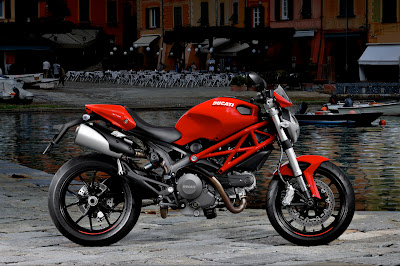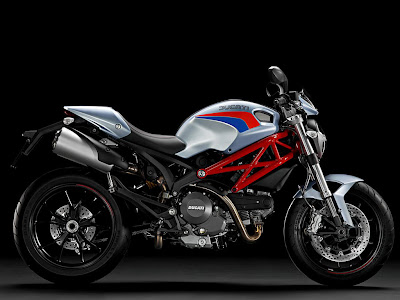 Picking up a motorcycle can be dangerous and cause serious injury if done incorrectly or under poor footing. A simple back injury could wreck your life! Always, always, always try to get help first—and remember, you don't want anybody else to get hurt, either. You need to think clearly, use common sense, and be in good physical condition. Keep your body and back straight, and lift only with your legs. Maintain control of the motorcycle and never twist your body while lifting. Check the motorcycle for damage prior to riding it again.
Picking up a motorcycle can be dangerous and cause serious injury if done incorrectly or under poor footing. A simple back injury could wreck your life! Always, always, always try to get help first—and remember, you don't want anybody else to get hurt, either. You need to think clearly, use common sense, and be in good physical condition. Keep your body and back straight, and lift only with your legs. Maintain control of the motorcycle and never twist your body while lifting. Check the motorcycle for damage prior to riding it again.
The majority of picking up a motorcycle is mental: Work smarter, not harder. Motorcycles are heavy machines. Think about how you want to do it first—if you were going to lift a 300-pound refrigerator, would you just run up and grab it and start muscling it around, or would you plan your attack? What would you do if you were going to lift an 800-pound refrigerator?
The ideal situation for lifting a motorcycle would be:
1. Have the lifting technique demonstrated by a qualified professional.
2. Practice with a qualified professional.
3. Have the qualified professional evaluate and coach your lifting technique.
Step 1: Assess Yourself
Take a few minutes to calm down. Seeing your bike lying on its side can be a traumatic experience, but it happens to everyone at one time or another. Your bike's not going anywhere without you. Spend a few minutes asking yourself questions and talking yourself through it: are you hurt? Are you able to pick up your motorcycle in a normal situation? Do you want to pick up your motorcycle? Is it safe to pick up your motorcycle? Etc., etc. You have the rest of your life to pick up your bike; take a few minutes to relax and assess the situation. It's best if you get help. And remember: if someone helps you, don't forget to warn them not to touch the hot exhaust pipe, not to lift by the turn signals, etc. Also make sure they lift correctly. You don't want someone else getting hurt.
Step 2: Assess the Environment
If you are in danger from other traffic, get away from your motorcycle and seek a place of safety. Let law enforcement respond and take control of the scene before picking up your motorcycle. Take a look at the ground: do you have a solid surface to lift from? Is there gravel? Is the pavement wet? Are you right next to a ditch? You don't want to slip and get pinned under your bike.
Step 3: Assess the Motorcycle
Turn it off using the engine cut-off switch or the ignition switch. Turn off the fuel using the fuel supply valve. Spilled fuel is common, so use caution (though usually you need sparks, flame, or an ignition source to have a fire or explosion.) If the motorcycle is lying on its right side, put the sidestand down and put the motorcycle in gear. If the motorcycle is on its left side, you can't put the side stand down and can't put the motorcycle in gear. Make a mental note of these facts. You don't want to pick up your motorcycle and then immediately drop it onto its other side! Techniques to Lift the Motorcycle—Preferred and Regular Methods.
Technique I: Facing Away from the Motorcycle - For Large Motorcycles Preferred Method for any Size
1. Turn the handlebars to full-lock position with front of tire pointed downward.
2. Find the "balance point" of the two tires and the engine, engine guard, or footpeg. The motorcycle will be fairly easy to lift until it reaches this point because it's resting on its side. Once you start lifting from there, you are responsible for the most of the weight of the bike.
3. "Sit" down with your butt/lower back against the motorcycle seat. Be very careful to keep your back straight and your head up. Put your feet solidly on the ground about 12 inches apart, with your knees bent slightly.
4. With one hand, grasp the handgrip (underhand, preferably), keeping your wrist straight.
5. With your other hand, grip the motorcycle framework (or any solid part of the motorcycle), being careful to avoid the hot exhaust pipe, turn signals, etc.
6. Lift with your legs by taking small steps backwards, pressing against the seat with your butt and keeping your back straight. On slippery or gravelly surfaces this technique probably won't work. On inclined surfaces this can be very dangerous.
7. Be careful not to lift the motorcycle up and then flip it onto its other side! If possible, put the sidestand down and the bike in gear.
8. Set the motorcycle on its sidestand and park it safely.
Technique II: Facing the Motorcycle - For Small and Medium-Sized Motorcycles Regular Method.
1. Turn the handlebars to the full-lock position with the front of the tire pointed skyward.
2. Find the balance point of the two tires and the engine, engine guard, or footpeg. The motorcycle will be fairly easy to lift until it reaches this point because it's resting on its side. Once you start lifting from there, you are responsible for the most of the weight of the bike.
 3. Stand very close to the handlebars. Plant your feet about shoulder-width apart with the lower handgrip in between them. Use both hands to lift. Keeping your back straight and your head up, lift carefully, keeping the handgrip close to your body. Use your leg muscles for power, and not your back muscles.
3. Stand very close to the handlebars. Plant your feet about shoulder-width apart with the lower handgrip in between them. Use both hands to lift. Keeping your back straight and your head up, lift carefully, keeping the handgrip close to your body. Use your leg muscles for power, and not your back muscles.
 4. Be careful you don't lift the motorcycle up and then flip it onto its other side.
4. Be careful you don't lift the motorcycle up and then flip it onto its other side.
 5. Set the motorcycle on its sidestand and park it safely.
5. Set the motorcycle on its sidestand and park it safely.
 2. BLIND SPOTS Motorcycles are easily hidden in traffic. Always take a second look over your shoulder—don’t rely solely on your mirrors for information.
2. BLIND SPOTS Motorcycles are easily hidden in traffic. Always take a second look over your shoulder—don’t rely solely on your mirrors for information.








































































